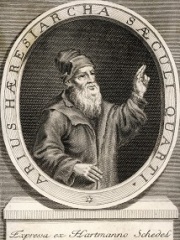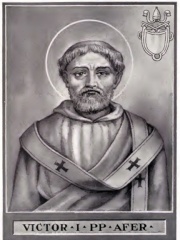


The Most Famous
RELIGIOUS FIGURES from Libya
This page contains a list of the greatest Libyan Religious Figures. The pantheon dataset contains 3,187 Religious Figures, 3 of which were born in Libya. This makes Libya the birth place of the 70th most number of Religious Figures behind Democratic Republic of the Congo, and Norway.
Top 3
The following people are considered by Pantheon to be the most legendary Libyan Religious Figures of all time. This list of famous Libyan Religious Figures is sorted by HPI (Historical Popularity Index), a metric that aggregates information on a biography's online popularity.

1. Mark the Evangelist (10 - 68)
With an HPI of 85.33, Mark the Evangelist is the most famous Libyan Religious Figure. His biography has been translated into 84 different languages on wikipedia.
Mark the Evangelist (Koinē Greek: Μᾶρκος, romanized: Mârkos), also known as John Mark (Koinē Greek: Ἰωάννης Μᾶρκος, romanized: Iōánnēs Mârkos; Aramaic: ܝܘܚܢܢ, romanized: Yōḥannān) or Saint Mark, was an Egyptian who is traditionally ascribed to be the author of the Gospel of Mark. Most modern scholars agree that the gospel of Mark is anonymous, though the topic remains contentious among experts. Scholarship is inconclusive on authorship; some reject the attribution to Mark while others debate the identity of Mark. According to Church tradition, Mark founded the episcopal see of Alexandria, which was one of the five most important sees of early Christianity. His feast day is celebrated on April 25, and his symbol is the winged lion.

2. Arius (256 - 336)
With an HPI of 81.19, Arius is the 2nd most famous Libyan Religious Figure. His biography has been translated into 70 different languages.
Arius (; Koine Greek: Ἄρειος, romanized: Áreios; 250 or 256 – 336) was a Cyrenaic presbyter and ascetic. He has been regarded as the founder of Arianism, which holds that Jesus Christ was not coeternal with God the Father, but was rather created directly by God the Father before anything else, as the true Firstborn. Arian theology and its doctrine regarding the nature of the Godhead showed a belief in radical subordinationism, a view notably disputed by 4th century figures such as Athanasius of Alexandria. Constantine the Great's formal decriminalization of Christianity into the Roman Empire entailed the convention of ecumenical councils to remove theological divisions between opposing sects within the Church. Arius's theology was a prominent topic at the First Council of Nicaea, where Arianism was condemned in favor of Homoousian conceptions of God and Jesus. Opposition to Arianism remains embodied in the Nicene Creed, described as "a deliberately anti-Arian document." Nevertheless, despite concerted opposition, Arian churches persisted for centuries throughout Europe (especially in various Germanic kingdoms), the Middle East, and North Africa. They were suppressed by military conquest or by voluntary royal conversion between the fifth and seventh centuries. Arius's role as the sole originator of Arian theology has been disputed by historians such as Rowan Williams, who stated that "Arius' role in 'Arianism' was not that of the founder of a sect. It was not his individual teaching that dominated the mid-century eastern Church." Richard Hanson writes that Arius' specific espousal of subordinationist theology brought "into unavoidable prominence a doctrinal crisis which had gradually been gathering[...] He was the spark that started the explosion. But in himself he was of no great significance." The association between Arius and the theology titled after him has been argued to be a creation "based on the polemic of Nicene writers" such as Athanasius of Alexandria, a Homoousian.

3. Pope Victor I (100 - 199)
With an HPI of 74.96, Pope Victor I is the 3rd most famous Libyan Religious Figure. His biography has been translated into 76 different languages.
Pope Victor I (died 199) was a Roman African prelate of the Catholic Church who served as the Bishop of Rome in the late second century. The dates of his tenure are uncertain, but one source states he became pope in 189 and gives the year of his death as 199. He was born in the Roman Province of Africa. He was later considered a saint. His feast day is celebrated on 28 July as "St Victor I, Pope and Martyr". He was of Berber origin.
People
Pantheon has 3 people classified as Libyan religious figures born between 10 and 256. Of these 3, none of them are still alive today. The most famous deceased Libyan religious figures include Mark the Evangelist, Arius, and Pope Victor I.

